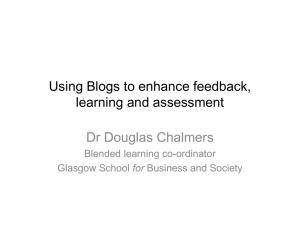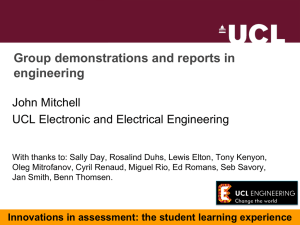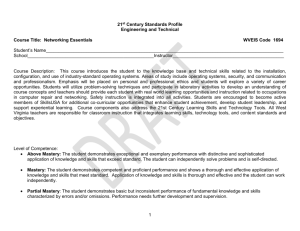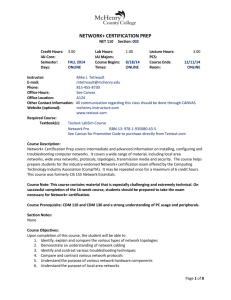Unit Descriptor
advertisement
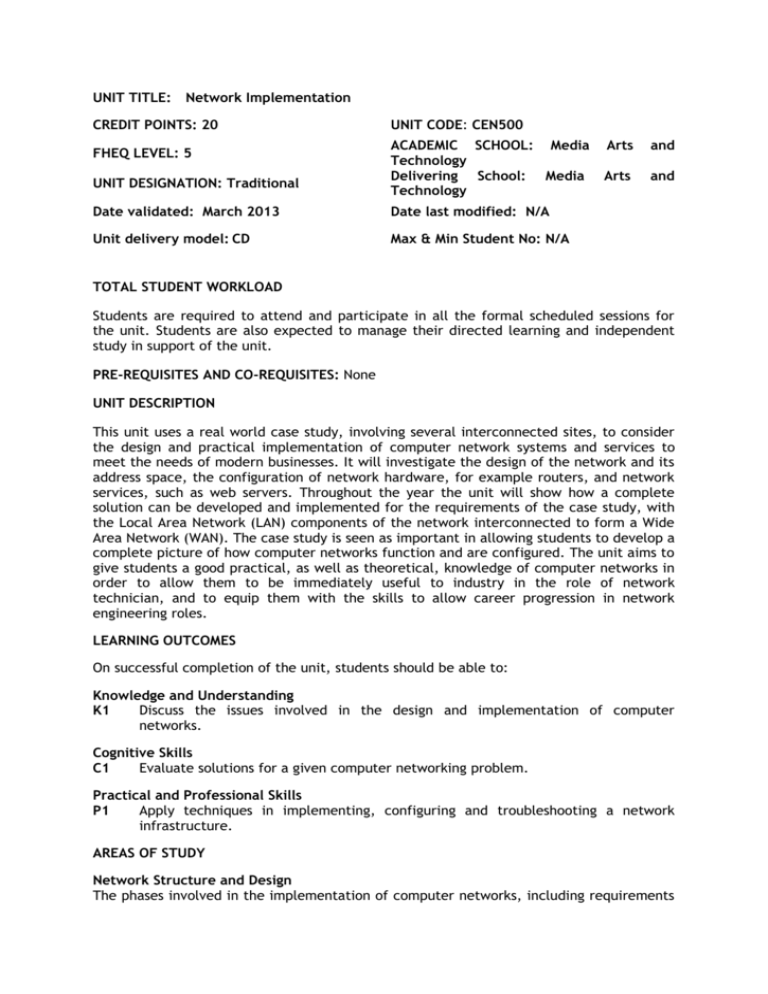
UNIT TITLE: Network Implementation CREDIT POINTS: 20 FHEQ LEVEL: 5 UNIT DESIGNATION: Traditional UNIT CODE: CEN500 ACADEMIC SCHOOL: Media Technology Delivering School: Media Technology Date validated: March 2013 Date last modified: N/A Unit delivery model: CD Max & Min Student No: N/A Arts and Arts and TOTAL STUDENT WORKLOAD Students are required to attend and participate in all the formal scheduled sessions for the unit. Students are also expected to manage their directed learning and independent study in support of the unit. PRE-REQUISITES AND CO-REQUISITES: None UNIT DESCRIPTION This unit uses a real world case study, involving several interconnected sites, to consider the design and practical implementation of computer network systems and services to meet the needs of modern businesses. It will investigate the design of the network and its address space, the configuration of network hardware, for example routers, and network services, such as web servers. Throughout the year the unit will show how a complete solution can be developed and implemented for the requirements of the case study, with the Local Area Network (LAN) components of the network interconnected to form a Wide Area Network (WAN). The case study is seen as important in allowing students to develop a complete picture of how computer networks function and are configured. The unit aims to give students a good practical, as well as theoretical, knowledge of computer networks in order to allow them to be immediately useful to industry in the role of network technician, and to equip them with the skills to allow career progression in network engineering roles. LEARNING OUTCOMES On successful completion of the unit, students should be able to: Knowledge and Understanding K1 Discuss the issues involved in the design and implementation of computer networks. Cognitive Skills C1 Evaluate solutions for a given computer networking problem. Practical and Professional Skills P1 Apply techniques in implementing, configuring and troubleshooting a network infrastructure. AREAS OF STUDY Network Structure and Design The phases involved in the implementation of computer networks, including requirements analysis, design, implementation and testing. Planning the address space and address conservation techniques, eg. subnetting and Network Address Translation. IPv4 versus IPv6. Designing and drawing network diagrams, for example using Cisco Packet Tracer. Modelling network designs using simulation software, for example using Opnet. Local and Wide Area Network Systems and Technologies Interconnection and configuration of network devices such as routers and switches. The interconnection of LANs by means of WAN technologies, including the Internet, whilst ensuring security of data in transit, for example VPNs. Introduction to basic network security, for example firewalls. Wireless LANs and Security Introduction to Wireless networks and communication. Implementing, securing and managing wireless networks for small and large enterprises. Implementing Computer Networks Practical and theoretical issues involved in the implementation and configuration of computer network systems and services in the real world, for example DNS and DHCP. Implementing web servers and Internet services, for example IIS or Apache. Troubleshooting, Monitoring and Management Issues and techniques for troubleshooting, monitoring and managing computer networks. Troubleshooting tools, eg. ipconfig, tracert, pathping, nslookup, wireshark. LEARNING AND TEACHING STRATEGY The teaching and learning strategy for this unit will be based on a real world case study based on a typical modern business, involved in e-commerce, and with several offices at various sites. This scenario will give scope for the full range of computer network systems and services necessary to support a typical enterprise. Preparation sessions will be used to introduce the theoretical concepts, consider the requirements of the case study, and investigate solutions. Once they have an understanding of the theory and practice of these, students will implement them in a practical workshop in order to meet the requirements of the scenario. A student centred approach will be adopted in which students will realise the implementation of solutions for themselves by means of directed learning. They will be expected to maintain a selfmanaged logbook or notes that they will use as background material for summative assessment. To support learning on this unit, students will encounter a range of learning opportunities involving classroom and lab based activities. The MyCourse Virtual Learning Environment (VLE) will be used to provider additional resources, such as videos and links to other material. ASSESSMENT STRATEGY There will be two summative assessments, with opportunities for formative assessment throughout the year. Students will be expected to take notes during preparation sessions and practical laboratories to use in the summative assessments, though this will not directly form part of the assessment. For the first summative assessment students will be expected to develop an educational training package, based around the case study mentioned in the teaching and learning strategy above that could be used to teach the subject of network implementation to an adult audience. The training package will be delivered in the form of a report which will consist of teaching notes that introduce each topic within the subject, in the context of the scenario, and reference supporting material such as presentation slides, speaker notes, figures, quizzes and other innovative material, for example videos of practical tasks. The second summative assessment will consist of a practically based time-constrained assignment (TCA). This will employ simulation software to enable students to design and draw a diagram of a computer network according to a given scenario, and configure the network devices and server services on the network. Students will be able to use the notes taken during preparation and laboratory sessions. The output of this assessment will be the network diagram, device and server configurations and answers to questions about observations made during the TCA. ASSESSMENT AE1 weighting: assessment type: length/duration: online submission: grade marking: anonymous marking: AE2 weighting: assessment type: length/duration: online submission: grade marking: anonymous marking: 60% Report 3000 words Yes No No 40% Time-Constrained Assignment 2 hours open book No No No Aggregation of marks The marks for each element of assessment will be aggregated to produce an overall mark for the unit. Re-assessment Arrangements Referral in AE1 will require revision and resubmission of the report and supporting evidence in the light of tutor feedback. Laboratory access may be required to obtain data and other evidence to support this. Referral in AE2 will require the student to submit an equivalent piece of work based on the use of simulation software. Unit Author: Neville Palmer and Jomo Batola Date of version: March 2013

